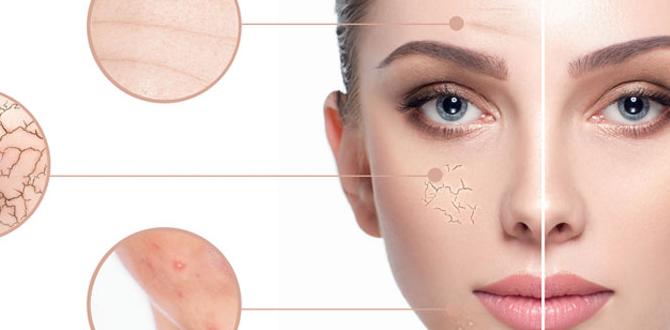Many teens struggle with skin that feels sensitive and irritated. Does this sound like you? Dealing with breakouts, redness, and dryness can feel overwhelming. But don’t worry! An easy sensitive skin routine can make a big difference and help you feel confident.
Imagine waking up excited to take care of your skin. What if you could have a simple plan that keeps your skin happy and healthy? With just a few steps, you can create a skincare routine that works for your sensitive skin.
Did you know that about 50% of teens face skin issues? That’s a lot of people! So, you are not alone. Understanding your skin is the first step to finding the right products. Who wouldn’t want to learn how to soothe and protect their skin with no fuss?
In this article, we will guide you through the easy sensitive skin routine for teens. It’s time to discover what your skin loves and how to take care of it! Get ready to enjoy clearer, calmer skin and feel great.
Easy Sensitive Skin Routine For Teens: Simple Steps To Follow
Easy Sensitive Skin Routine for Teens
Teen skin can be tricky, especially if it’s sensitive. A simple routine helps keep it clear and healthy. Start with a gentle cleanser to wash away dirt without irritation. Next, use a lightweight moisturizer to hydrate without clogging pores. Sunscreen is a must to protect from harmful rays. Did you know using natural products can calm redness and irritation? Remember, less is often more! This routine is easy, and it works!Understanding Sensitive Skin
Definition of sensitive skin. Common causes and symptoms.
Sensitive skin is like that one friend who gets easily upset over little things. It can feel itchy, red, or even sting when faced with certain products or weather. Common causes include harsh soaps, hot water, and even stress—yes, your skin can be dramatic! Symptoms often show up as dryness, rashes, or an annoying tingling sensation. Lucky for you, understanding your skin helps you keep it happy.
| Common Causes | Symptoms |
|---|---|
| Harsh soaps | Redness |
| Hot water | Itching |
| Weather changes | Dry patches |
| Stress | Tingling |
Identifying Your Skin Type
Signs of sensitive skin versus other skin types. Importance of knowing your skin type for routine selection.
Figuring out your skin type is like unlocking a treasure chest! Sensitive skin has its own signs. It can feel *itchy*, *red*, or *dry*. You might notice reactions to products that others can happily use. It’s like your skin saying, “Hey, I need special care!” Knowing your skin type helps you choose the right routine. Without that, picking products can feel like a game of Toss-It and Guess. Here’s a quick table to help you spot the differences:
| Skin Type | Signs |
|---|---|
| Sensitive | Redness, stingy feelings, reacts to products |
| Oily | Shiny, large pores, acne-prone |
| Dry | Flaky, rough, tightness |
| Normal | Balanced, few breakouts, smooth |
Understanding your skin type is key to a happy routine. Like knowing what flavor ice cream to order, it makes everything easier!
Essential Steps for a Sensitive Skin Routine
Gentle cleansing techniques. Choosing nonirritating products.
Starting a good skin routine can feel like preparing for a science experiment! First, always use a gentle cleanser. Splash on some water and softly rub your face. No need to scrub like you’re washing a dirty car! Next, pick products that say “non-irritating.” If they sound like they belong in a chemistry lab, just walk away. Your skin deserves a cozy blanket, not a wrestling match with harsh ingredients!
| Gentle Cleansing Tips | Non-Irritating Products |
|---|---|
| Use warm, not hot, water. | Look for labels that say “fragrance-free.” |
| Pat dry with a soft towel. | Avoid alcohol-based products. |
| Limit cleansing to twice a day. | Choose gels or creams designed for sensitive skin. |
Choosing the Right Ingredients
Key ingredients to look for in products. Ingredients to avoid for sensitive skin.
Picking products for sensitive skin can feel like a treasure hunt. You want the good stuff and to avoid the bad. Key ingredients to look for include aloe vera and chamomile because they are soothing heroes. You should dodge ingredients like fragrance and alcohol; they are like the party crashers of skincare. Here’s a handy table to help you out!
| Ingredients to Look For | Ingredients to Avoid |
|---|---|
| Aloe Vera | Fragrance |
| Chamomile | Alcohol |
| Oat Extract | parabens |
Choosing the right ingredients is like finding the perfect pizza toppings: you want what tastes good and feels great!
Daily Skin Care Routine for Teens
Morning and evening routines. Importance of consistency in skin care.
A great skin care routine can feel as fun as a rollercoaster ride! In the morning, splash your face with water and use a gentle cleanser to wake your skin up. Follow that with a light moisturizer to keep your face happy. In the evening, wash off the day with the same cleanser and use a soothing lotion. Remember, consistency is key. Stick to your routine, and your skin will thank you. Just like brushing your teeth, daily care helps keep your face fresh!
| Morning Routine | Evening Routine |
|---|---|
| 1. Splash water | 1. Cleanse with gentle soap |
| 2. Use gentle cleanser | 2. Remove makeup (if any) |
| 3. Apply light moisturizer | 3. Apply soothing lotion |
Additional Tips for Managing Sensitive Skin
The role of diet and hydration. Sun protection strategies.
Taking care of sensitive skin involves more than washing your face. Diet matters too! Eating fruits, vegetables, and drinking water helps keep your skin clear and healthy. Sunscreen is key for protection against the sun. Use a broad-spectrum sunscreen, with SPF 30 or higher, even on cloudy days. Avoid direct sun during peak hours.
- Choose foods rich in antioxidants.
- Stay hydrated by drinking plenty of water.
- Wear protective clothing or hats in the sun.
How does diet affect sensitive skin?
A healthy diet can reduce skin irritation and improve overall skin health. Foods high in vitamins and minerals help provide your skin with what it needs to stay strong and clear.
Why is sun protection important?
Sun protection prevents sunburn and skin damage. It can also help avoid long-term issues like wrinkles and skin cancer.
Common Mistakes to Avoid
Overexfoliating and harsh products. Ignoring skin changes and reactions.
Many teens make a few common mistakes that can hurt their sensitive skin. First, some go overboard with scrubs, thinking more is better. This is known as overexfoliating. It can leave skin red and angry, kind of like a ripe tomato! What about products? Harsh soaps and toners might sound tough, but they’re usually not friends with gentle skin.
Another biggie is ignoring changes in the skin. If your face starts to react—think breakouts or irritation—it’s essential to pay attention. Listen to your skin, it knows best! If only our pets could talk like that.
| Common Mistakes | Effects |
|---|---|
| Overexfoliating | Red, irritated skin |
| Using harsh products | Dryness and breakouts |
| Ignoring changes | Worsening skin problems |
When to Consult a Dermatologist
Signs you need professional help. What to expect during a dermatological consultation.
Skin issues can be tricky. You should see a dermatologist if you notice redness, rashes, or persistent acne. These signs may mean you need a professional’s advice. During your visit, expect a friendly chat about your skin. The doctor will ask questions about your routine and symptoms. They may suggest treatments or tests to help you.
How do I know when to see a dermatologist?
If your skin is very irritated or painful, it’s time to go. Warning signs include:
- Severe acne
- Rashes that won’t go away
- Itching that disrupts daily life
- Dry patches that bleed or swell
Trust your gut. If something feels off, don’t wait!
Conclusion
In conclusion, caring for sensitive skin as a teen doesn’t need to be hard. Start with gentle cleansers and moisturizers that suit your skin. Avoid harsh chemicals and always use sunscreen. Listen to your skin’s needs. For more tips, check out skincare blogs or consult a dermatologist. You can make your routine easy and effective!FAQs
Sure! Here Are Five Related Questions On The Topic Of An Easy Sensitive Skin Routine For Teens:Taking care of sensitive skin is important. First, always use gentle soap and water to wash your face. Next, apply a light moisturizer to keep your skin soft. Don’t forget to use sunscreen when you go outside to protect your skin from the sun. Finally, if something irritates your skin, stop using it right away.
Sure! Please give me the question you want answered, and I’ll provide a simple and clear response.
What Gentle Cleanser Is Recommended For Teens With Sensitive Skin?A good gentle cleanser for teens with sensitive skin is Cetaphil Gentle Skin Cleanser. It’s soft and helps clean your skin without hurting it. You can use it every day. Remember to rinse it off well with water! This will help keep your skin happy and healthy.
How Can Teens Identify If They Have Sensitive Skin Versus Dry Or Acne-Prone Skin?To find out if you have sensitive skin, look for redness or itching. If your skin feels tight and rough, it might be dry. Acne-prone skin often has bumps or pimples. You can try using different products and see how your skin reacts. If you notice irritation or breakouts, that can help you understand your skin type better.
What Are Some Soothing Ingredients To Look For In Moisturizers For Sensitive Skin?When choosing moisturizers for sensitive skin, look for calming ingredients. Aloe vera helps cool and soothe your skin. Oatmeal can reduce itching and redness. Chamomile is a flower that calms skin irritation. Glycerin keeps your skin hydrated and soft. These ingredients can help your skin feel better and stay happy!
How Often Should Teens With Sensitive Skin Exfoliate, And What Type Of Exfoliant Is Safest To Use?Teens with sensitive skin should exfoliate about once a week. This keeps your skin healthy without hurting it. Use a gentle scrub or a mild chemical exfoliant, like one with milk or fruit. Always test it on a small area first. If it feels okay, you can use it!
Are There Any Specific Sun Protection Tips For Teens With Sensitive Skin?If you have sensitive skin, use sunscreen with SPF 30 or higher. Look for one that says “sensitive skin” on the bottle. Apply it every two hours, especially after swimming or sweating. Wear a hat and sunglasses to protect your face and eyes. Stay in the shade when the sun is really strong.
